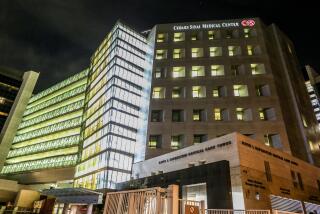How I Made It: Thomas M. Priselac of Cedars-Sinai Health System
- Share via
Los Angeles TimesThe gig: Thomas M. Priselac is president and chief executive of Cedars-Sinai Health System, a sprawling complex in Los Angeles with 11,000 employees, vast research and teaching programs and the largest private, nonprofit medical center in the Western United States.
The red carpet: Cedars-Sinai has long been associated with Hollywood. George Burns Road and Gracie Allen Drive run through its middle right past the Steven Spielberg Pediatric Research Center. “We have the reputation as the hospital to the stars. That’s something we’re very proud of,” says Priselac, 59. “People who can go anywhere in the world choose to come here, I believe, because they know they’re going to get world-class care.”
The basics: But Priselac bridles at the notion that Cedars-Sinai Medical Center might be thought of as a spa hospital. There are no executive suites for famous guests, as some have suggested, he says. And the hospital serves large indigent and elderly populations. “On one side of Cedars-Sinai, you have Beverly Hills,” he said. “On the other, you have the Fairfax district and all areas of Los Angeles we serve.”
A major player: Priselac presides over a medical complex with 958 hospital beds, 2,000 doctors, $2 billion in annual revenue and major research institutes in genetics, neurosurgery, cancer and cardiology. He’s also a force on the national healthcare scene, the past chairman of the American Hospital Assn., who was invited to the White House last year with other industry leaders to advise President Obama on the healthcare overhaul.
Almost Aquaman: Priselac grew up in suburban Pittsburgh, a place he described as “small-town industrial America.” He attended Catholic grade school, played cornerback on his high school football team and dreamed at one point of becoming a marine biologist. “It was ‘Jacques Cousteau,’ the TV show,” he says of that early influence.
An unexpected turn: After earning a bachelor’s degree in biology and a master’s degree in public health-health services administration and planning (he’s not a doctor), he went to work as an administrator for Pittsburgh’s Montefiore Hospital. Los Angeles had never crossed his mind — that is, until his future wife, an Angeleno he met through his secretary, gave him an ultimatum when he proposed. “She said, ‘I think it’s a great idea, and I love you, but I’m not living in Pittsburgh,’ ” he recalled.
And so Priselac moved west and secured a job in 1979 as an assistant administrator at Cedars-Sinai thanks to a recommendation from his boss back in Pittsburgh. He and wife Jody, a UCLA education professor, settled in Santa Monica and raised a family. The couple have two adult sons.
First-day shakes: Priselac worked his way up the Cedars-Sinai corporate ladder, claiming the top job on Jan. 17, 1994 — the day of the Northridge earthquake. He remembers that he was calm as he raced to work that morning but thought to himself, “I can’t believe this is happening on my first day.”
Two medical buildings and an employee parking structure suffered extensive structural damage (and were later torn down). Cedars-Sinai’s relatively new main medical center — it was 18 years old at the time — survived with little more than broken pipes and smashed equipment. There were no major injuries.
At a staff meeting a few days later, a group of employees passed out T-shirts with a message emblazoned across the front: “I survived Tom Priselac’s first day on the job.”
Running strong: Priselac still has the same lean build as he did 40 years ago when he played in the defensive backfield for Turtle Creek High School outside Pittsburgh. That makes sense: He works out five days a week — running, biking, swimming — to keep his body fit and his mind loose, quipping that he has “attention deficit disorder” when it comes to sports.
Staying power: The typical hospital CEO lasts an average of four to five years on the job. Priselac has survived 17. All told, he’s been at Cedars-Sinai 31 years, including 10 as its chief operating officer. The secret to his longevity, he says, rests in a few simple rules that apply to running any large organization: “Be accessible. Be honest. Be determined.”






